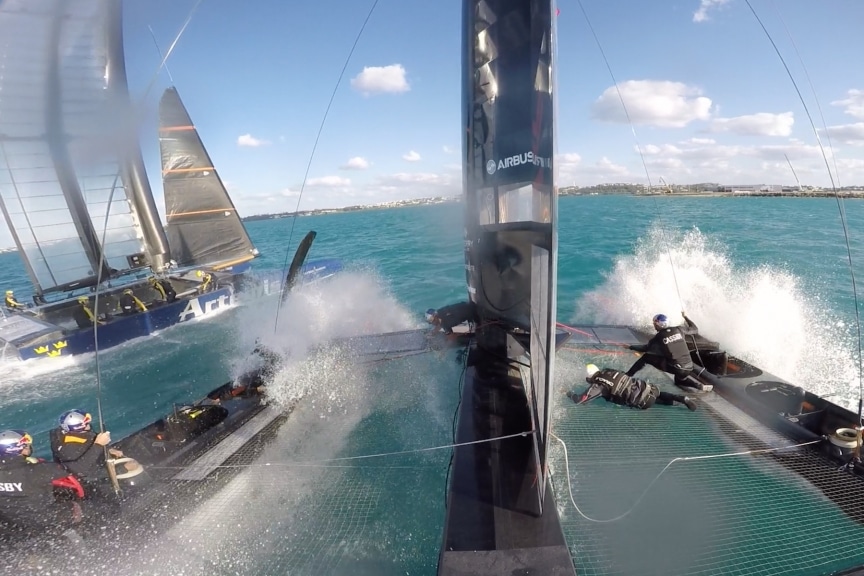American sailors Andrew Campbell and Rome Kirby have two of the more unique jobs on the ORACLE TEAM USA sailing team.
During tacks and gybes, they are the ‘caretaker’ helmsmen, who are first across to the new windward side of the boat, and who steer the boat for the 5 seconds or so that it takes for the regular helm – Tom Slingsby or Jimmy Spithill – to run across and get in position.
“It’s a bit of a case of ‘here you go, don’t screw it up!'” according to skipper Spithill.
But despite limited time at the wheel, the potential for taking over at just the right – or wrong – moment is very real.
Consider the video below. Andrew Campbell is barely in shot in the bottom left of the screen. He has just run across the trampoline and taken over the wheel during a gybe.
Artemis Racing, closing in at speed from the left, is on starboard and has rights, so the original call was for ORACLE TEAM USA to heat up – to turn to port (left) – and pass behind Artemis Racing.
But then, the Swedish boat came off the foils, nearly stopping. In a split second, and having had the wheel in his hands all of about five seconds, Campbell had to make the call to turn to starboard (right) instead, bringing his boat off the foils in a spectacular splashdown.
Tom Slingsby, the regular helmsman, had just run across the boat and had his hands on the wheel as well. By the time both boats had come to a near stop in the water, just a yard or two apart, Slingsby was on the wheel, and Campbell was on his feet, heading the wing to push it to leeward by hand to help get the boat moving again.

“There wasn’t a lot of room for maneuvering there, we would have been going near 30 knots, and they would have been even faster, so it was a pretty fast closing speed. They touched down right when we would have gone behind them, but it became apparent very quickly we wouldn’t have room to do that.
“Right up until the moment where they touched down our move was to go behind and everybody was ready for that, but you need to be able to adjust quickly.”
Campbell says the key to staying safe is to have a playbook and to know what the boats are capable of doing.
“Safety is always in mind, you always know what the exit move is, what the safe option is,” he says.
He says he and Rome Kirby, who also has this role during tacks and gybes, lobby for time on the helm to ensure they have the skills and instincts to deal with unexpected situations.
“We want to make sure we are comfortable. There are scenarios where what happens in those five seconds when the regular helmsman is running across the boat could make a difference in the race,” he explains.
“At these speeds, your reaction time is reduced, but it is the same reaction. You have to know what the plays are before you get into the situation. You know what your play is and what their counter-play is, so when you see they aren’t on their normal play, you are ready to make a quick adjustment.”
At closing speeds upwards of 50 knots, it better be quick.









